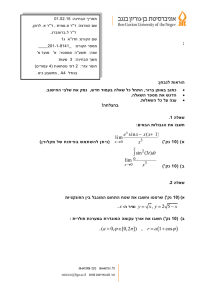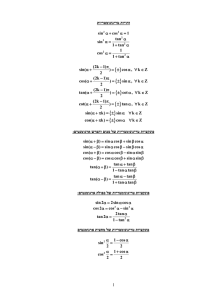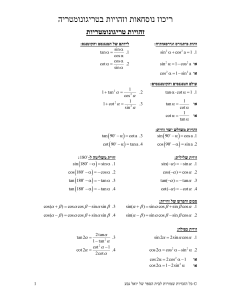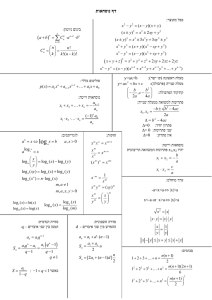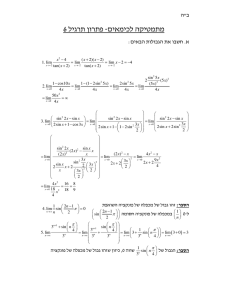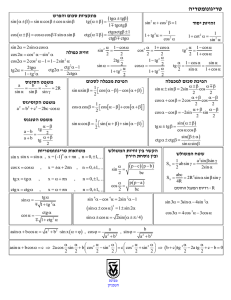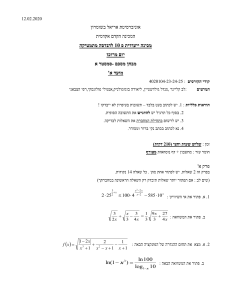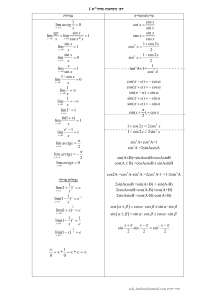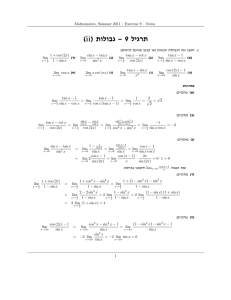פתרון תרגיל בית 3 בחשבון אינפיניטסימלי 2 133־89 סמסטר ב - Math-Wiki
Anuncio
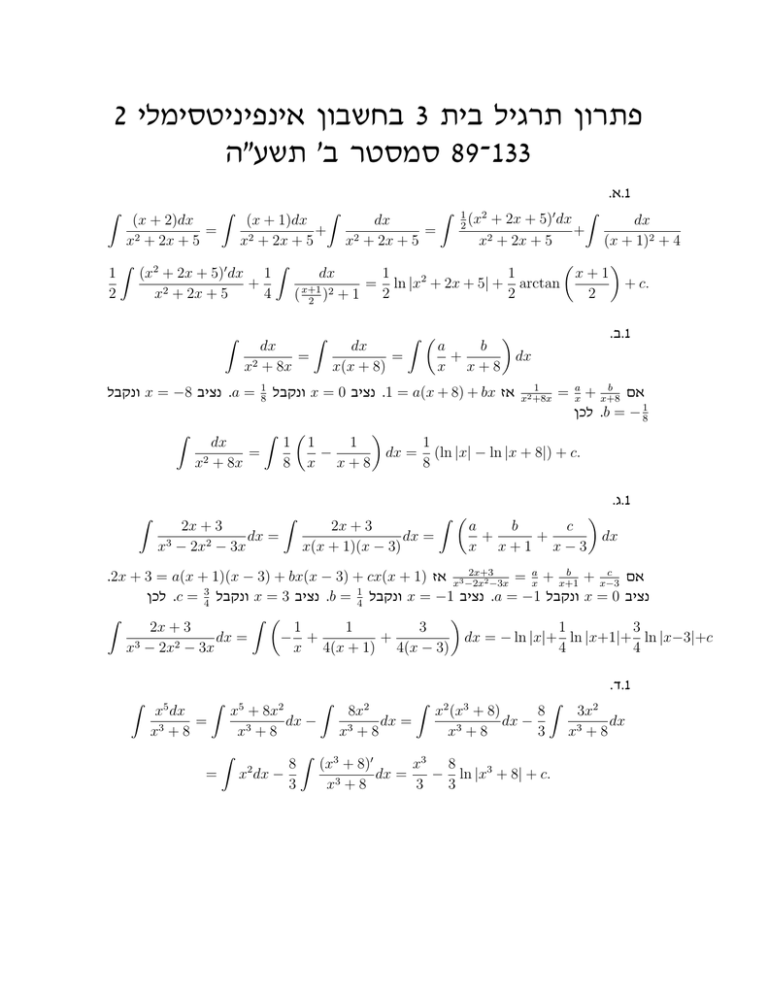
2 בחשבון אינפיניטסימלי3 פתרון תרגיל בית סמסטר ב' תשע"ה89־133 .א.1 Z 1 (x2 + 2x + 5)0 dx dx (x + 2)dx 2 = + x2 + 2x + 5 x2 + 2x + 5 (x + 1)2 + 4 Z Z 1 (x2 + 2x + 5)0 dx 1 dx 1 1 x+1 2 + = ln |x + 2x + 5| + arctan + c. 2 x2 + 2x + 5 4 2 2 2 ( x+1 )2 + 1 2 Z Z Z Z (x + 1)dx dx + = x2 + 2x + 5 x2 + 2x + 5 Z dx = x2 + 8x ונקבלx = −8 נציב.a = Z dx = 2 x + 8x 1 8 Z dx = x(x + 8) Z a b + x x+8 ונקבלx = 0 נציב.1 = a(x + 8) + bx אז Z 1 8 1 1 − x x+8 dx = .ב.1 dx 1 x2 +8x = a x b + x+8 אם לכן.b = − 18 1 (ln |x| − ln |x + 8|) + c. 8 .ג.1 Z x3 2x + 3 dx = − 2x2 − 3x Z 2x + 3 dx = x(x + 1)(x − 3) Z b c a + + x x+1 x−3 dx 2x+3 a b c .2x + 3 = a(x + 1)(x − 3) + bx(x − 3) + cx(x + 1) אזx3 −2x 2 −3x = x + x+1 + x−3 אם לכן.c = 34 ונקבלx = 3 נציב.b = 14 ונקבלx = −1 נציב.a = −1 ונקבלx = 0 נציב Z Z 1 1 3 3 2x + 3 1 dx = − + + ln |x+1|+ ln |x−3|+c dx = − ln |x|+ x3 − 2x2 − 3x x 4(x + 1) 4(x − 3) 4 4 .ד.1 Z x5 dx = x3 + 8 x5 + 8x2 dx − x3 + 8 Z Z = 8 x dx − 3 2 Z Z 8x2 dx = x3 + 8 Z x2 (x3 + 8) 8 dx − 3 x +8 3 Z (x3 + 8)0 x3 8 dx = − ln |x3 + 8| + c. 3 x +8 3 3 3x2 dx x3 + 8 .ה.1 Z x4 + 4 dx = x2 (x2 + 4) Z x4 + 4x2 dx−4 x2 (x2 + 4) Z x2 − 1 dx = x2 (x2 + 4) Z Z dx−4 a b c + 2+ 2 x x x +4 dx 2 a b c אוx2 − 1 = ax(x2 + 4) + b(x2 + 4) + cx2 אזx2x(x−1 2 +4) = x + x2 + x2 +4 אם x מהשוואת המקדמים של החזקות המתאימות של, ax3 + (b + c − 1)x2 + 4ax + 4b + 1 = 0 לכן.c = 45 ,b = − 14 ,a = 0 נקבל ש־ ! Z Z Z Z x4 + 4 5 5 1 1 1 dx = dx − − dx = x − − dx x2 (x2 + 4) x2 + 4 x2 4 x 2 + 1 x2 2 =x− x 5 1 arctan − + c. 2 2 x קודם נדאג שמעלת המונה תהיה קטנה ממעלת המכנה.ו.1 Z Z 4 Z 4 Z Z Z x4 x +x−x x +x x x dx = dx = dx − dx = xdx − dx 3 3 3 3 3 x +1 x +1 x +1 x +1 x +1 a נציב.x = a(x2 − x + 1) + (bx + c)(x + 1) אז, x3x+1 = (x+1)(xx2 −x+1) = x+1 + x2bx+c אם −x+1 2 בשניx מהשוואת המקדמים של.a + c = 0 ונקבלx = 0 נציב.3a = −1 ונקבלx = −1 מכאן נקבל.a = − 13 , b = 13 , c = 13 לכן.a + b = 0האגפים נקבל ש־ Z Z Z Z 1 Z (2x − 1) + 32 1 dx 1 x+1 x2 1 1 x4 2 dx = xdx− + dx = − ln |x+1|+ dx x3 + 1 3 x+1 3 x2 − x + 1 2 3 3 x2 − x + 1 Z Z x2 1 1 (2x − 1)dx 1 dx = − ln |x + 1| + + 2 3 6 x2 − x + 1 2 x2 − x + 1 Z Z x2 1 1 (x2 − x + 1)0 dx 1 dx = − ln |x + 1| + + 2 2 2 3 6 x −x+1 2 x − 12 + 43 1 1 2x − 1 x2 1 2 √ = − ln |x + 1| + ln |x − x + 1| + √ arctan + c. 2 3 6 3 3 x a b c כלומר, (x+1)(x+2) 2 = x+1 + x+2 + (x+2)2 נחפש פירוק מהצורה.ז.1 x = −2 נציב.a = −1 ונקבלx = −1 נציב.x = a(x + 2)2 + b(x + 2)(x + 1) + c(x + 1) לכן.b = 1 לכן,a + b = 0 נקבלx2 מהשוואת המקדמים של.c = 2 ונקבל Z Z Z x dx dx dx =− + +2 2 (x + 1)(x + 2) x+1 x+2 (x + 2)2 = − ln |x + 1| + ln |x + 2| − 2 2 + c. x+2 .א.2 Z Z dx 2dt 1 − t2 = x = 2 arctan(t), dx = = , cos(x) = cos(x) 1 + t2 1 + t2 Z = 1 1−t2 1+t2 2dt 1 + t2 1 1 + dt = − ln |1 − t| + ln |1 + t| + c 1−t 1+t x x = − ln 1 − tan + ln 1 + tan + c. 2 2 2dt = 1 − t2 Z .ב.2 Z Z dx 2dt 2t = x = 2 arctan(t), dx = , sin(x) = = sin(x) 1 + t2 1 + t2 Z x dt = ln |t| + c = ln tan = + c. t 2 1 2t 1+t2 2dt 1 + t2 .ג.2 Z √ Z p 1 − x2 1 − sin2 (t) cos(t)dt dx = [x = sin(t), dx = cos(t)dt] = x sin(t) Z p h π πi i Z cos2 (t)dt cos2 (t) cos(t)dt h = t = arcsin(x) ∈ − , ⇒ cos(t) ≥ 0 = = sin(t) 2 2 sin(t) Z Z Z (1 − sin2 (t))dt t dt = + cos(t) + c = = − sin(t)dt = ln tan ∗ sin(t) sin(t) 2 arcsin(x) + cos(arcsin(x)) + c, ln tan 2 ע"י שימוש בזהויות טריגונומטריות אפשר להראות גם ש־.ב.2 במעבר )*( השתמשנו בסעיף √ arcsin(x) x 2 √ cos(arcsin(x)) = 1 − x , tan = . 2 1 + 1 − x2 .ד.2 Z √ x2 − 1 1 sin(t)dt dx = x = , dx = = x2 cos(t) cos2 (t) Z s 1 − cos2 (t) sin(t)dt = cos2 (t) 3 Z s Z s 1 sin(t)dt − 1 cos2 (t) 2 cos (t) cos2 (t) sin2 (t) sin(t) cos2 (t) Z Z sin2 (t)dt (1 − cos2 (t))dt 1 t = arccos ∈ [0, π] ⇒ sin(t) ≥ 0 = = ∗ x cos(t) cos(t) Z Z dt t + ln 1 + tan t − sin(t) + c = − cos(t)dt = − ln 1 − tan ∗∗ cos(t) 2 2 ! ! arccos x1 arccos x1 1 +c = − ln 1 − tan + ln 1 + tan − sin arccos 2 2 x היינו מגיעים לאותה תוצאה )אבלcos(t) ≤ 0 אם היינו מניחים ש־,cos(t) ≥ 0 ב ־ )*( הנחנו ש־ בעזרת זהויות טריגונומטריות.2. ב־ )**( התשמשנו בסעיף א.(זה תרגיל לא פשוט להראות זאת אפשר להוכיח ש־ ! ! √ 1 + x + x2 − 1 arccos x1 arccos x1 √ − ln 1 − tan + ln 1 + tan = ln 2 2 1 + x − x2 − 1 .sin arccos( Z 1 x √ = x2 −1 x ו־ .ה.2 2dt 1 − t2 2t dx = x = 2 arctan(t), dx = , cos(x) = , sin(x) = 7 cos(x) − 4 sin(x) + 8 1 + t2 1 + t2 1 + t2 2dt 1+t2 Z = 7(1−t2 ) 1+t2 − 8t 1+t2 Z +8 = 2dt = 2 7(1 − t ) − 8t + 8(1 + t2 ) נציב.a = −2 ונקבלt = 3 נציב.2 = a(t − 5) + b(t − 3) אז Z Z t2 2dt − 8t + 15 2 (t−3)(t−5) a b = t−3 + t−5 אם לכן.b = 1 ונקבלt = 5 1 1 − + dt = − ln |t − 3| + ln |t − 5| + c t−3 t−5 x x = − ln tan − 3 + ln tan − 5 + c. 2 2 2dt = 2 t − 8t + 15 Z .ו.2 Z 1 (sin(a + b) + sin(a − b)) 2 1 1 ⇒ sin(x) cos(2x) = (sin(3x) + sin(−x)) = (sin(3x) − sin(x)) 2 2 Z Z Z 1 1 1 = (sin(3x) − sin(x)) cos(3x)dx = sin(3x) cos(3x)dx − sin(x) cos(3x)dx 2 2 2 sin(x) cos(2x) cos(3x)dx = sin(a) cos(b) = 4 1 = 4 Z 1 sin(6x)dx − 4 Z (sin(4x) − sin(2x)) dx = − cos(6x) cos(4x) cos(2x) + − + c. 24 16 8 .ז.2 Z tan3 (x)dx = Z tan2 (x) tan(x)dx = Z = tan(x) dx − cos2 (x) t = tan(x), dt = dx cos2 (x) Z Z tan(x) dx = cos2 (x) Z 1 cos2 (x) − 1 tan(x)dx Z tan(x)dx • לחישוב האינטגרל הראשון נשתמש בהצבה tdt = t2 tan2 (x) +c= + c. 2 2 • לחישוב האינטגרל השני נשתמש בפונקציית הלוגריתם Z Z Z sin(x) (cos(x))0 tan(x)dx = dx = − dx = − ln | cos(x)| + c. cos(x) cos(x) לכן קיבלנו ש־ Z Z tan2 (x) tan3 (x)dx = + ln | cos(x)| + c. 2 sin(2x)dx 1 = [y = 2x, dy = 2dx] = 2 + sin(2x) 2 Z .ח.2 sin(y)dy 2 + sin(y) 2dt 1 − t2 2t = y = 2 arctan(t), dy = , cos(y) = , sin(y) = 2 2 1+t 1+t 1 + t2 Z 2t 2dt Z tdt 1 1+t2 1+t2 2t = 2 2 (1 + t )(1 + t + t2 ) 2 + 1+t2 נכפיל את שני האגפים t (1+t2 )(1+t+t2 ) = at+b 1+t2 + ct+d . 1+t+t2 ,נשתמש בפירוק לשברים חלקיים ( ונקבל1 + t2 )(1 + t + t2 )ב־ t = (at + b)(1 + t + t2 ) + (ct + d)(1 + t2 ) = (a + c)t3 + (a + b + d)t2 + (a + b + c)t + b + d. בשני האגפים נקבלt מהשוואת המקדמים של החזקות המתאימות של a + c = 0, a + b + d = 0, a + b + c = 1, b + d = 0 ⇒ b = 1, d = −1. לכן קיבלנו ש־ 5 Z Z = Z tdt = 2 (1 + t )(1 + t + t2 ) dt − 1 + t2 Z t+ dt 1 2 2 + 3 4 1 1 − 2 1+t 1 + t + t2 4 = arctan(t) − 3 2 = arctan(t) − √ arctan 3 2 = x − √ arctan 3 2t + 1 √ 3 6 Z dt dt 2 2t+1 √ 3 + c = [t = tan(x)] 2 tan(x) + 1 √ 3 + c. +1
